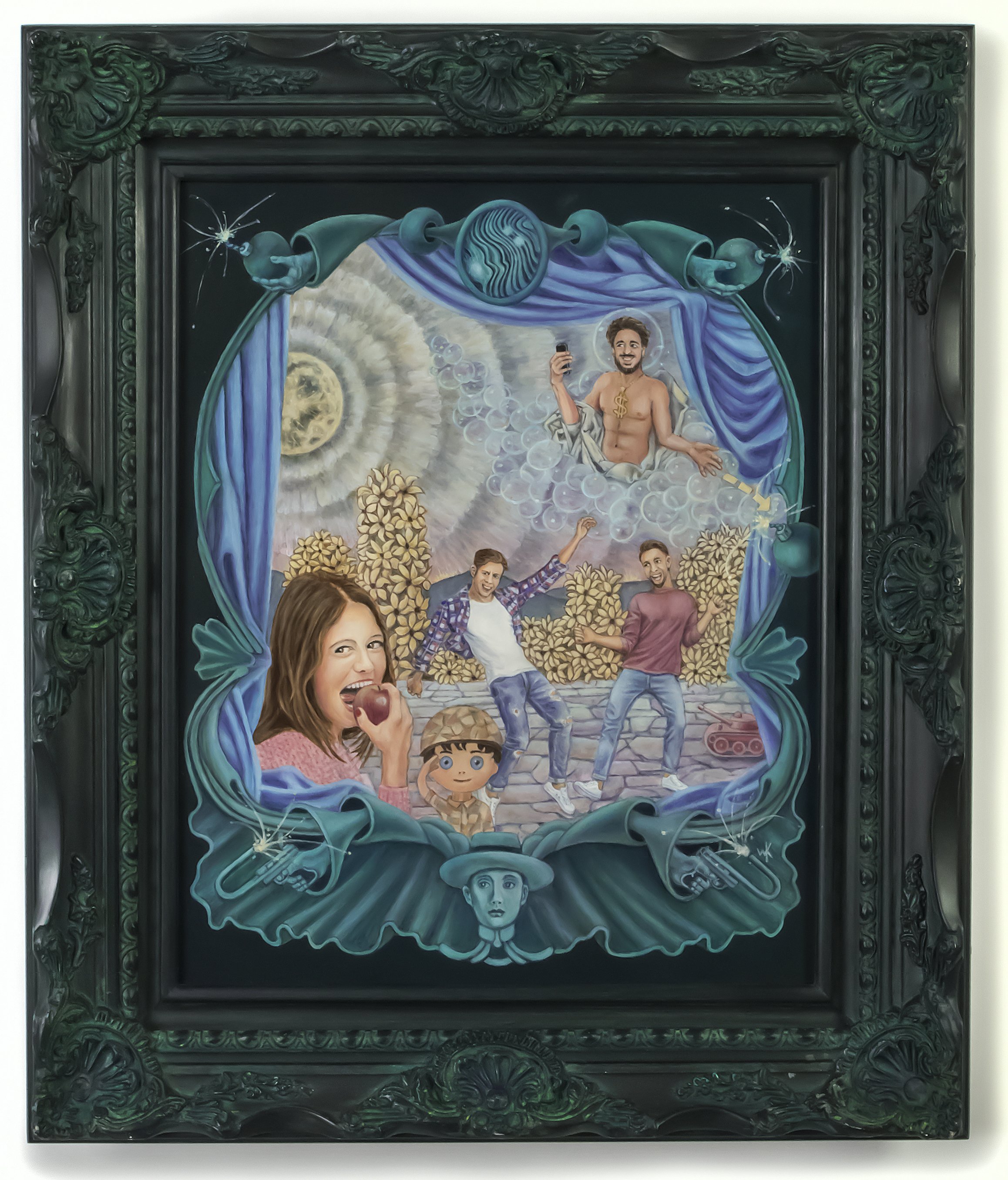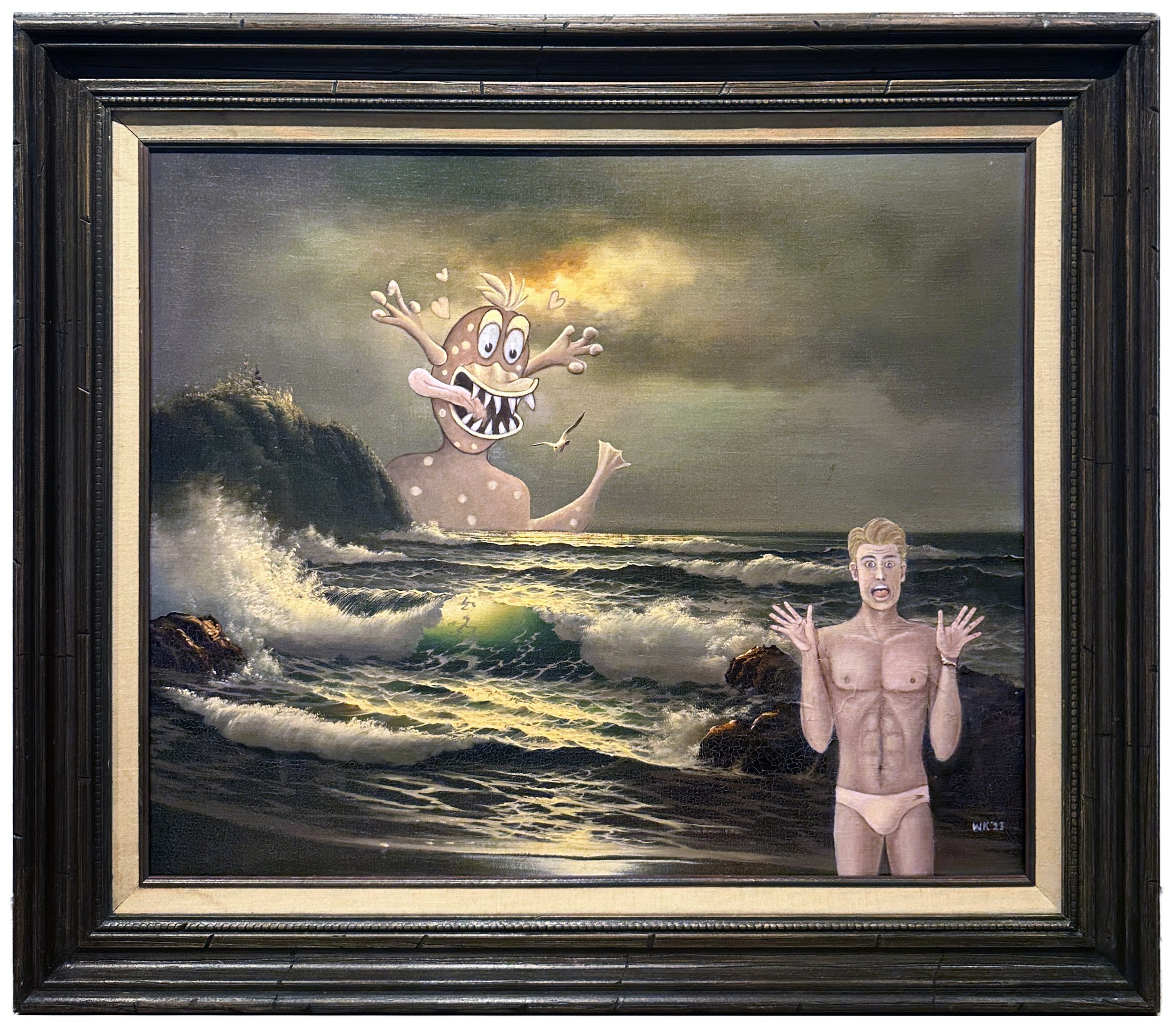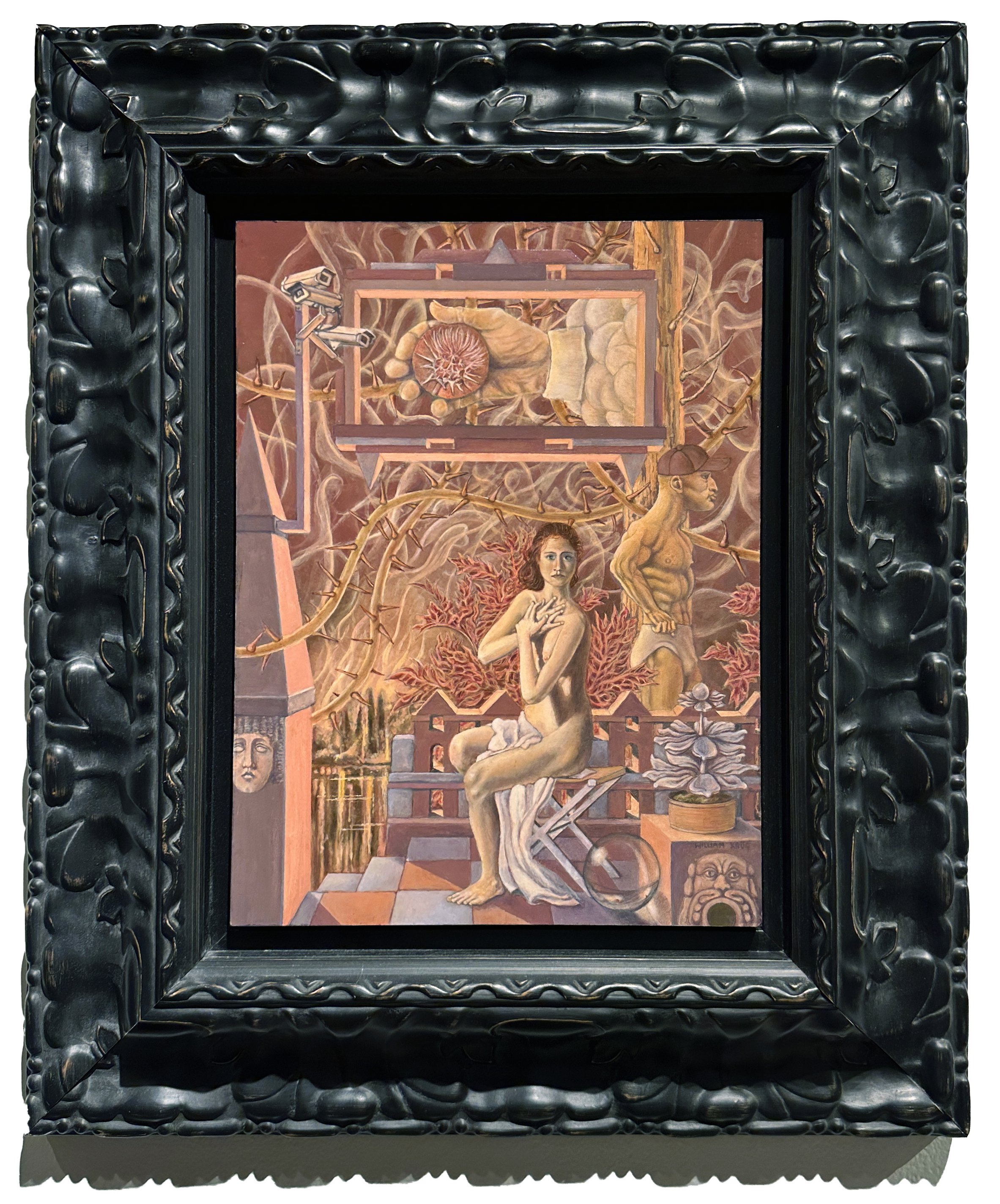William Krug Gallery

William Krug
Landscape with the Ghost of Cubism Basting a Pagan Martyr
oil on panel
24 × 24 inches framed
Price: 2,500.
While planning this painting, I was preoccupied with Albert Camus' philosophy of Absurdism, or, more specifically, finding joy in the absurdity of existence. Considering current world and national events, it seemed an attractive approach to life and would help my gloom grow into a happier form of nihilism. It did. Albrecht Durer also inspired this image. While paging through a book of his woodblock prints, I found a depiction of a man being cooked in a pot; one man was operating bellows to keep the fire hot, and another man appeared to be "basting" the martyr with a pail attached to a stick. The image was farcical to me and fodder for an Absurdist painting. The Christian martyr became a "pagan" martyr based on my reading about early Christianity. Christians were thought to have persecuted both "pagans" and classical books almost equally, and they always were obsessed with the sex other people were having. Other elements of this painting are open to the interpretations of the viewer, and I hope that the queer camp and absurdist aspects of my work contribute to my goal of joyfully mocking the delusions of the self-righteous. Cheers! –Wm

William Krug
Pastoral Scene With the God of your Choice Casually Tossing a Bomb (an allegory of War)
oil on panel
Price: 2,8000.
More info? Click here.
Although the Dutch philosopher Benedict de Spinoza believed God was everything, he believed that all the strife, violence and bigotry spawned by religion was due to man anthropomorphizing God. Mankind has always created their gods in their own image and likeness.
I was raised to believe in the tripartite Judeo-Christian God and thought the trinity was unique to Christianity. Eventually I realized that Christians appropriated this concept from the many trinitarian gods of the ancient world. Questioning what the persons in a current triadic god may be I concluded with greed, narcissism and dopamine hits, and suspected it had always been that way. The more intellectually abstract Buddhists summarized all this as delusion.
In my painting the dancing boys are as happy as can be because they experienced the enlightenment of knowing life is meaningless. They're creating their own meaning. At lower left is Eve recreating the greatest sin in Western Civilization, a woman seeking knowledge, and laughing at the misogyny of whoever created that folktale. Meanwhile delusion generated violence surrounds and threatens all. Cheers! –Wm

William Krug
La-La Tempesta
oil on panel
23.5 × 23.5 inches framed
SOLD
Lamenting the lack of clear queer imagery in Renaissance painting I decided to paint a Gay version of "La Tempesta" by Giorgione. The small creature in the foreground is facially expressing "kiss off if you don't like it." There's an Albrecht Durer tree and a lewdly leering herm from Tiepolo. Since I painted this the ever entertaining and brilliant Waldemar Januszczak has explained the myth that inspired Giorgione's painting. Cheers! –Wm

William Krug
In the Land of the Free (with Phosphorous Bombs)
oil on panel
25.5 × 21.5 inches framed
SOLD
This painting originated with a photo of Phosphorous bombs in the 2010 issue of World Press Photo. Phosphorous bombs are known to burn flesh to the bone, are outlawed by the Geneva Convention, and were being used on an oppressed people. With the exploding bombs are "dollar pyramids," together they reveal violence and greed on a pastel horizon. Front left is a herm derived from Mantegna lamenting the loss of virtue. In the foreground is a family group. I painted the child holding an assault rifle after reading about the number of children that die of gunshot wounds. The woman gazes up at a comic book-like hero. In his book on the Greek Heroes Stephen Fry said that the "heroes cleansed our world of...earth-born monsters that endangered mankind and threatened to choke the rise of civilization." While painting this I thought about disproving Susan Sontag's statement that Camp is never political. Cheers! –Wm

William Krug
Terror at Hollywood Beach
oil on salvaged painting
26 × 30 inches framed
price: 950.
This framed seascape was found torn, forlorn, covered with dust and headed for a dumpster. I saw it as an opportunity to express an on-going theme in my life - unrequited love… lust. Cheers! –Wm

William Krug
Tilt-A-Whirl
oil on panel
27.5 × 23.25 inches framed
SOLD
The Face of Self-Righteous Delusion rides the night sky seeking it's glorification both on Earth and in Heaven. It is accompanied by various enablers. There are also spectators. The large pink pear shaped creature is a "Hungry Ghost" of Buddhist lore. Hungry ghosts are insatiable in their needs and consume everything in their path, but since they have no anus it all festers inside. The pointing and laughing figure on the far left is the artist and/or death. The man in the foreground expresses bemused bewilderment, while baseless rage appears above him. The discarded carnival head adds to the atmosphere of nihilist frivolity. Cheers! –Wm

William Krug
Untitled
oil on panel
25.5 × 21.5 inches framed
price: 1,500.
More Info? Click Here.
This painting was inspired by Rembrandt’s “Susanna and the Elders”, especially Simon Schama’s commentary on it, and the “Me Too” movement. It depicts a vulnerable woman looking at the viewer while the male figure was derived from an Italian Fascist sculpture. Rembrandt’s painting depicts only one elder as it was assumed the other elder (voyeur) is the viewer. The painting also contains references to global warming, Surveillance Capitalism, and a thistle. According to the Penguin Dictionary of Symbols, thistles “like all prickly plants are a symbol of the protective belt defending the heart against external harm and attacks”. Cheers! –Wm

William Krug
Temptation of St. Anthony
oil on panel
23.5 × 20.5 inches framed
Price: 1,500.
More info? Click here.
This painting was inspired by my attempts to understand the feelings of young Black men who I would see on public transportation going to and from classes or jobs. I admired their fortitude in attempting to fit into a society that expresses such irrational hatred and fear of them. My "Saint Anthony" is tempted by a gun, unlike the legendary "Saint Anthony" who was tempted by sex. The destructive Clarence Thomas and George Zimmerman are lower right. We've backed Black men into a corner where drug dealing is one of the few options open for their survival. Although Blacks and Whites abuse drugs at the same rate, the so called "War on Drugs" is only enforced on Blacks.
The action takes place in Millennium Park in Chicago. Part of the Plensa Fountain is reimagined as a memorial to Richard M. Daley, whose ethically dubious parking meter deal only benefits the rich, and not the city. Cheers! –Wm

William Krug
Melancholia
oil on panel
22.5 × 21.5 inches framed
SOLD
This painting, inspired by Albrecht Durer's "Melancholia 1," was done during the Covid Pandemic and the last year of the Trump presidency. Hopes for the future of the planet and for a non-fascist government became bleak. I tried to think of a melancholic image that wouldn't read as kitsch. The result was a bumble bee impaled on the spire of a gold prison. The flaming forest in the background evolved into a something oddly sinister. Surveillance Capitalism appears. There's a malnourished dog and a young man wearing a tribal mask. Masked rituals have had many powers ascribed to them, including healing psychic illness and restoring mankind to a pristine state. Cheers! –Wm

William Krug
Still Life with Race Riot
oil on panel
16 x 12 inches
SOLD
A precious moment in the heart of darkest America. This painting has an obvious message, that racism and homophobia are taught to children, they're not innate. Such things are taught by people who need to denigrate others to feel better about themselves. It's something we're all guilty of, some more than others. This painting was enhanced by my fascination with the "flower" still life paintings of Franz Sedlacek, an Austrian artist lost in World War II. Cheers! –Wm
